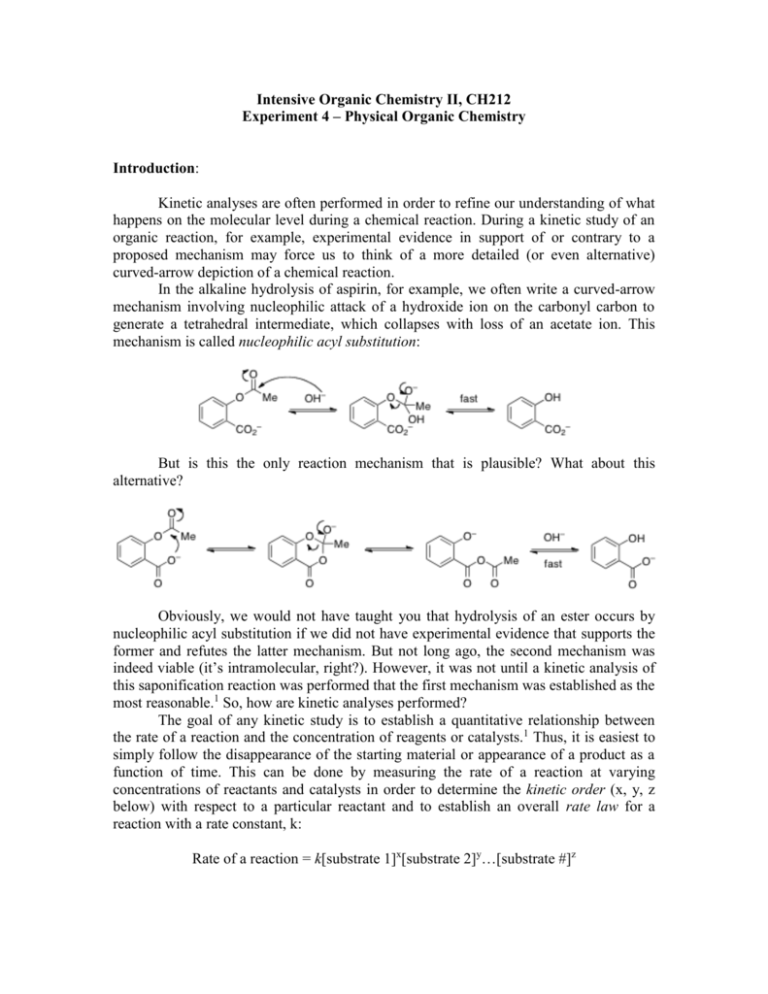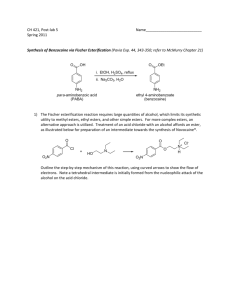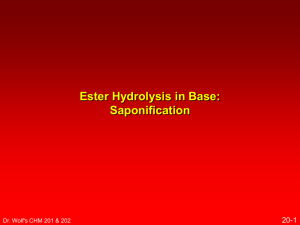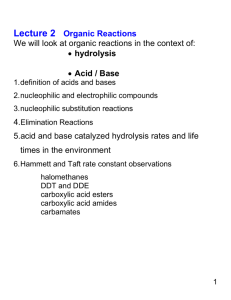View/Download
advertisement

Intensive Organic Chemistry II, CH212 Experiment 4 – Physical Organic Chemistry Introduction: Kinetic analyses are often performed in order to refine our understanding of what happens on the molecular level during a chemical reaction. During a kinetic study of an organic reaction, for example, experimental evidence in support of or contrary to a proposed mechanism may force us to think of a more detailed (or even alternative) curved-arrow depiction of a chemical reaction. In the alkaline hydrolysis of aspirin, for example, we often write a curved-arrow mechanism involving nucleophilic attack of a hydroxide ion on the carbonyl carbon to generate a tetrahedral intermediate, which collapses with loss of an acetate ion. This mechanism is called nucleophilic acyl substitution: But is this the only reaction mechanism that is plausible? What about this alternative? Obviously, we would not have taught you that hydrolysis of an ester occurs by nucleophilic acyl substitution if we did not have experimental evidence that supports the former and refutes the latter mechanism. But not long ago, the second mechanism was indeed viable (it’s intramolecular, right?). However, it was not until a kinetic analysis of this saponification reaction was performed that the first mechanism was established as the most reasonable.1 So, how are kinetic analyses performed? The goal of any kinetic study is to establish a quantitative relationship between the rate of a reaction and the concentration of reagents or catalysts.1 Thus, it is easiest to simply follow the disappearance of the starting material or appearance of a product as a function of time. This can be done by measuring the rate of a reaction at varying concentrations of reactants and catalysts in order to determine the kinetic order (x, y, z below) with respect to a particular reactant and to establish an overall rate law for a reaction with a rate constant, k: Rate of a reaction = k[substrate 1]x[substrate 2]y…[substrate #]z Spectroscopic techniques such as 1H NMR, IR, and UV-Vis provide a quick, easy, and continuous method of monitoring changes in concentration. In the hydrolysis of aspirin above, the rate order with respect to hydroxide ion was determined to be one (not zero), thus eliminating the second mechanism which involves no hydroxide ion in the rate-determining step of the reaction. We understand now that the second reaction mechanism is unreasonable because it involves nucleophilic attack of a delocalized carboxylate ion onto the carbonyl. Even though this could happen intramolecularly, the carboxylate ion is too weak of a nucleophile. So, the rate law for the alkaline hydrolysis of an ester can be expressed as: Rate = k[aspirin]1[hydroxide ion]1 The reactivity of an organic molecule is often a consequence of which functional groups are attached or which substituents are present. You have seen this extensively in electrophilic aromatic substitution, whereby electron-withdrawing groups (-Cl, -Br, NO2, F, etc.) deactivate the benzene ring, making it more difficult to break aromaticity. This type of effect, whereby the structure of a compound has an influence on its reactivity, is called a quantitative structure-activity relationship.1,2 The Hammett equation: One classical example of a structure-activity relationship, which happens to be the subject of the experiment outlined herein, is defined by the Hammett equation. In 1937, L. P. Hammett noticed that the rates of reactions using starting materials containing substituted phenyl rings were proportional to the acid strengths of substituted benzoic acids.3 For example, Hammett observed that as the acidity of para-substituted benzoic acids increases, the rate of alkaline hydrolysis of para-substituted ethyl benzoates increased proportionally. This relationship is known as a linear free energy relationship.1 Linear free energy relationships arise when substituents are introduced into a molecule and the change in the free energy of ionization is directly proportional to the change in free energy of activation in a chemical reaction. In this experiment, we will concern ourselves with the Hammett equation as expressed for rate data: log(k/k0) =, where is a substituent constant inherent to a substituent that reveals its electronic influence and is a reaction constant that reflects the sensitivity of a reaction to substituent effects.1 (The Hammett equation can also be applied to equilibrium constants, log(K/K0) = ). Table 1 shows the values for a variety of substituents at the para-position of a phenyl ring.4 Electron-withdrawing groups ( > 0) favor acid ionization while electrondonating groups ( < 0) push the equilibrium in the opposite direction. Resonance, inductive, and field effects each contribute to the sign and magnitude of . Table 1. Substituent constants () for a variety of para-substitutions Substituent group -Ac 0.47 -NH2 –0.30 -Br 0.26 -Cl 0.24 -CN 0.70 -F 0.15 H 0 -OMe –0.12 -Me –0.14 -NO2 0.81 -CF3 0.53 Similarly, the magnitude and sign of provides valuable insight into the mechanism of the reaction being studied.5 For example, a positive indicates that electron-withdrawing groups facilitate the reaction and that negative charge builds up in the transition state. The opposite can be said for negative values. Table 2 shows the values for a variety of organic reactions. Notice that the reaction we will be studying in this experiment has a value of 2.61. Table 2. Reaction constants () for a variety of organic reactions Organic reaction 1.00 0.56 2.26 3.19 2.61 -1.31 -4.48 Consider the following scenario for this experiment: In this experiment, you will be performing a kinetic analysis of the alkaline hydrolysis of an ester. You will first synthesize one of several para-nitrophenyl meta- or para-substituted benzoates from the corresponding acid chlorides and para-nitrophenol in the presence of base. You will then hydrolyze this ester under alkaline conditions and monitor the rate of the reaction. Since the leaving group in this case, paranitrophenoxide, absorbs light at 407 nm (which will make the reaction mixture progressively more yellow), we can monitor the progress of this reaction by UV-Vis spectroscopy over time. A generic example is shown below: We have already told you that for the hydrolysis of an ester the kinetic order with respect to hydroxide ion is one. Your task will be to confirm whether the nucleophilic acyl substitution mechanism holds true for this reaction, namely that the kinetic order with respect to the ester substrate is also one. Since this reaction will be run under pseudo-first order conditions (excess hydroxide ion), the calculations to obtain the rate constant for this reaction should be simple. Finally, you will calculate the value from your rate data and the class as a whole in order to determine whether there exists any substituent effects in this reaction. This will allow you to better understand the mechanism of this hydrolysis reaction. Furthermore, you will be able to determine the effects of meta- versus para-substitution on the electronics of the hydrolysis reaction. All of these values can be compared to data reported in the literature. References: 1. F. A. Carey; R. J. Sundberg, Advanced Organic Chemistry, Part A: Structure and Mechanisms, 4th Ed. Kluwer Academic Press, New York, 2000. 2. J. Chem. Ed. 2008, 85, 558. 3. J. Am. Chem. Soc. 1937, 59, 96. 4. J. Org. Chem. 1979, 44, 4766. 5. P. R. Wells, Linear Free Energy Relationships, Academic Press, New York, 1968. Week 1: Preparation of the p-nitrophenyl benzoates Equipment: Microscale glassware kit Teledyne Isco RediSepRf 12 gram Silica Flash Columns HPLC vials NMR tubes and caps TLC plates (small) TLC plates (large) White-capped vials 1 mL syringes and needles 20 mL syringes and needles (may not be necessary) Chemicals: 4-Methoxybenzoyl chloride 3-Methoxybenzoyl chloride p-Toluoyl chloride m-Toluoyl chloride 4-Chlorobenzoyl chloride 3-Chlorobenzoyl chloride Benzoyl chloride 4-Nitrophenol Triethylamine Methylene chloride – 500 mL 1 N HCl – 200 mL 5% Aqueous sodium bicarbonate – 200 mL Saturated sodium chloride (brine) – 200 mL Anhydrous sodium sulfate Absolute ethanol – 200 mL Methanol CDCl3 Hexanes – 4 L (may not be necessary) Ethyl acetate – 2 L (may not be necessary) Procedure: adapted from J. Chem. Ed. 2008, 85 (4), 558. Synthesis: In a fume hood, dissolve 350 mg p-nitrophenol in methylene chloride (6 mL) in a white-capped vial. Add triethylamine (1.1 equiv.) via syringe and stir until the solid has dissolved, then cool to 0 °C. To this solution, slowly add your assigned substituted benzoyl chloride (1.0 equiv.) and then remove the ice bath and warm to room temperature. Stir at room temperature for 30 minutes. Monitor your reaction by TLC using a solvent system that will give you an Rf ~ 0.3–0.5. Workup: When your reaction is complete, quench the reaction with 5 mL water and transfer to a Falcon tube. Separate the two layers and wash the organic phase successively with 5 mL 1 N HCl, 5 mL sat. aq. NaHCO3, and 5 mL brine. Dry the solution over sodium sulfate, filter, and concentrate the solution to dryness in vacuo. Recrystallize your sample from a minimal amount of absolute ethanol and carefully vacuum filter/collect your crystals on a filter disc. If your product is not crystalline, you may need to run column chromatography. Analysis: Since your product will be likely be wet, place it in a tared vial and submit it to your TF to dry. Pre-Lab Questions: 1. If an isotopic labeling experiment was performed in the hydrolysis of aspirin, according to the nucleophilic acyl substitution mechanism, where would the isotopic label be found at the end of the reaction? 2. When you add triethylamine to the p-nitrophenol solution, a color change occurs. What is the reason for the color change (hint: what is responsible for the color of organic molecules?) 3. You will be purifying your ester by recrystallization. Review how to perform a recrystallization. Describe each step in this process. Week 2: A Kinetic Analysis of Ester Hydrolysis Equipment: Microscale glassware kit HPLC vials NMR tubes and caps TLC plates (small) White-capped vials 1 mL syringes and needles Melting point apparatus Spectronic 20 UV-Vis spectrophotometer 1 mL sample holders Chemicals: Acetone – 100 mL Deionized water 0.1 N NaOH – 100 mL CDCl3 Procedure: adapted from J. Chem. Ed. 2008, 85 (4), 558. NOTE: This experiment will be divided into two parts: kinetic analysis and characterization. You will be instructed on which part to start first by your TF. Half of the class will begin with the kinetic analysis while the other half is working on the characterization. Kinetic Analysis: For the kinetic experiment, you need to make a stock solution containing 500 M of your p-nitrophenyl ester. In a test tube, prepare about 1 mL of this stock solution in a solvent mixture containing 60% acetone/40% ethyl acetate (make about 10 mL of this solvent mixture at the beginning). Next, obtain about 2 mL of 0.1 N NaOH (aq.) in a second test tube. Bring each of these solutions to a UV-Vis spectrophotomer which should be set up to perform your rate analysis. In a 1 mL sample cell, add 0.9 mL 60% acetone/40% ethyl acetate followed by 0.1 mL of your stock solution. Use this solution to calibrate the instrument. Wash and dry the sample cell and then add 0.8 mL 60% acetone/40% ethyl acetate followed by 0.1 mL of your stock solution. Now, add 0.1 mL 0.1 N NaOH (aq.) to the sample cell and mix quickly with a Pasteur pipet. Immediately place the sample cell into the instrument and measure the absorbance at 407 nm over 10 s intervals for a total of 5 minutes (NOTE: make sure you record your data by hand in your notebook – the instrument will not record it for you!). When your time course has finished, wash and dry the sample cell and give it to the next person. Characterization: Obtain a dry yield of your product, in addition to a 1H NMR, IR, LC/MS, and melting point. Pre-Lab Questions: 1. The pKa of p-nitrobenzoic acid is 3.44; that of benzoic acid is 4.19. Calculate for p-NO2. 2. The value for alkaline saponification of methyl esters of substituted benzoic acids is 2.38, and the rate constant for saponification of methyl benzoate under the conditions of interest is 0.0002 M-1s-1. Calculate the rate constant for the hydrolysis of methyl p-nitrobenzoate using your answer to question #1. 3. Determine the values for all of the benzoic acid derivatives used in this experiment. Provide a reference from which you obtained your values. What do positive/negative values mean? 4. Using the pKa values of the benzoic acid derivatives used in this experiment and the pKa of benzoic acid itself, plot log(KX/KH) versus and calculate the slope of the line? What does this slope represent? Does it correlate well with literature values? What do the magnitude and sign of this slope mean chemically? Full Lab Report Additional Questions: (not necessarily in this order) 1. What is meant by pseudo-first order kinetics? 2. Why is a calibration curve not necessary in this experiment (hint: think about what your y-axis means)? 3. Plot ln(1-[At/Af]) vs time. What was the rate constant for your ester hydrolysis? Is this kobs or k? How could you calculate the other one? 4. Does your rate plot start at zero? If not, why might this not be the case (hint: what other nucleophiles are in your reaction?)? 5. What is the difference in rate values for m- vs. p-substitution? Does this make sense? 6. Plot log(kX/kH) vs. What value did you observe for this experiment? Does this agree with the literture value? 7. What does the value tell you about the organization of the transition state? What information does it glean about the mechanism of the reaction? 8. Is it better to have electron-withdrawing or electron-donating substituents in this reaction? How is this reflected in your own data? If the opposite were true, what would your plot of log(kX/kH) vs. look like? 9. According to your plot, calculate the rate constant for the alkaline hydrolysis of pnitrophenyl p-nitrobenzoate from the literature value for p-NO2. How does this compare with your answer to Pre-Lab question #2 from week #2? What might the difference be, if any exists? 10. Does the nucleophilic acyl substitution mechanism hold true according to your experimental results? What is the order with respect to the ester substrate? Does the preference for either electron-withdrawing or electron-donating groups make sense?









